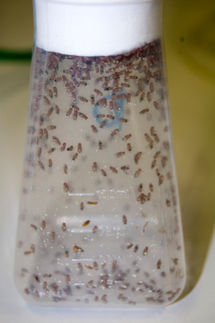Defective sweet taste receptor gene shapes cat cuisine
Genetic studies make purrfect sense: No sweet treats for kitty
Advertisement
Scientists from the Monell Chemical Senses Center, in collaboration with scientists from the Waltham Centre for Pet Nutrition, UK, report that a defect in a gene that codes for part of the mammalian sweet taste receptor can account for cats' indifference to sugar and other sweets.
Cat owners have long recognized that, unlike most mammals, domestic cats are uniformly uninterested in sweet-tasting foods. According to an early study conducted at Monell in the 1970s, the same indifference to sweets is also evident in wild cats such as lions, tigers, leopards, and jaguars.
"One possible explanation for this behavior is that felines are unable to detect sweet-tasting compounds like sugars and high intensity sweeteners because their sweet taste receptor is defective," comments Xia Li, PhD, a molecular geneticist at Monell and lead author of the current study. "An obvious place to look, therefore, is at the genes coding for the sweet-taste receptor."
The mammalian sweet receptor is composed of two protein subunits, known as T1R2 and T1R3. Each is coded for by a separate gene. In the new study, reported in the July 2005 inaugural issue of PLoS (Public Library of Science) Genetics, the researchers show a defect in the gene encoding the T1R2 protein in domestic cats.
The Monell researchers also detected the same gene defect in tiger and cheetah, suggesting that it is common to species throughout the cat family. "This type of gene is known as a pseudogene and is somewhat like a molecular fossil," says Li. "It presumably once coded a functional protein, but no longer does so."
Li explains, "Genes contain signals that indicate the start and stop points for information about the amino acid sequence of a given protein. We found a deletion of 247 base pairs in the gene that codes for T1R2 in the cat. As a consequence of this deletion, the stop point is shifted. The T1R2 protein is not made and thus is unavailable to join with T1R3 to form a working sweet taste receptor."
"Our results account for the common observation that the cat lives in a different sensory world than the cat owner," comments Véronique Legrand-Defretin, Ph.D, Director for the Global Feeding Behavior Research program at the Waltham Centre. "Waltham finds it critical to understand these unique characteristics of the cat in order to make foods that they not only enjoy but that also meet their unique nutritional needs."
Parallel studies showed that the defect is specific to the gene coding for the T1R2 protein, as the gene coding for the cat T1R3 protein is similar to those found in other mammals and appears to express a complete and functional protein.
The findings demonstrate the major role that genetic influences on taste play in food selection and consequently on nutrition.
"The non-functional sweet receptor provides a molecular explanation for why cats have no avidity for sweets," says senior author Joseph G. Brand, PhD, a Monell biophysicist. "Looking beyond this elegant explanation, one can contemplate the importance that this molecular change had on the evolution of the cat's carnivorous behavior."
"What we still don't know is - which came first: carnivorous behavior or the loss of the T1R2 protein? With regard to the gene, is this a case of use it or lose it?"
Brand continues, "From a nutritional viewpoint, since in the wild the cat eats very little carbohydrate, it is constantly consuming a high-protein diet. Perhaps the cat can teach us something of the physiological and metabolic consequences of diets restricted primarily to protein."
The data will be presented at the upcoming Waltham International Nutritional Sciences Symposium in Washington, DC, in September, along with numerous other advances in animal nutrition.





















































